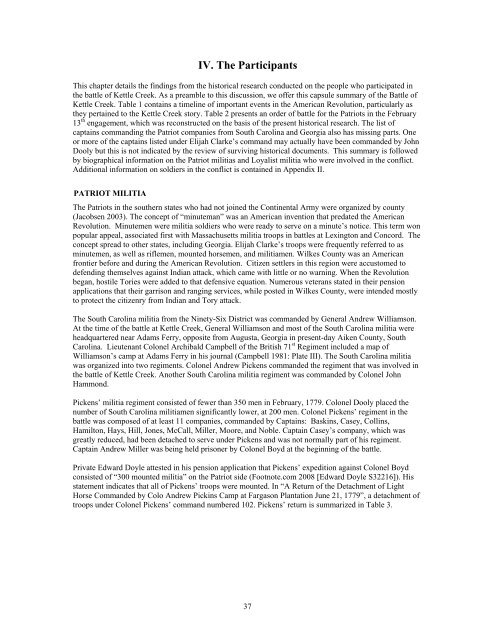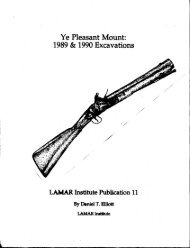Stirring Up a Hornet's Nest: - UGA Laboratory of Archaeology ...
Stirring Up a Hornet's Nest: - UGA Laboratory of Archaeology ...
Stirring Up a Hornet's Nest: - UGA Laboratory of Archaeology ...
You also want an ePaper? Increase the reach of your titles
YUMPU automatically turns print PDFs into web optimized ePapers that Google loves.
BIV. The Participants<br />
This chapter details the findings from the historical research conducted on the people who participated in<br />
the battle <strong>of</strong> Kettle Creek. As a preamble to this discussion, we <strong>of</strong>fer this capsule summary <strong>of</strong> the Battle <strong>of</strong><br />
Kettle Creek. Table 1 contains a timeline <strong>of</strong> important events in the American Revolution, particularly as<br />
they pertained to the Kettle Creek story. Table 2 presents an order <strong>of</strong> battle for the Patriots in the February<br />
13 th engagement, which was reconstructed on the basis <strong>of</strong> the present historical research. The list <strong>of</strong><br />
captains commanding the Patriot companies from South Carolina and Georgia also has missing parts. One<br />
or more <strong>of</strong> the captains listed under Elijah Clarke’s command may actually have been commanded by John<br />
Dooly but this is not indicated by the review <strong>of</strong> surviving historical documents. This summary is followed<br />
by biographical information on the Patriot militias and Loyalist militia who were involved in the conflict.<br />
Additional information on soldiers in the conflict is contained in Appendix II.<br />
BPATRIOT MILITIA<br />
The Patriots in the southern states who had not joined the Continental Army were organized by county<br />
(Jacobsen 2003). The concept <strong>of</strong> “minuteman” was an American invention that predated the American<br />
Revolution. Minutemen were militia soldiers who were ready to serve on a minute’s notice. This term won<br />
popular appeal, associated first with Massachusetts militia troops in battles at Lexington and Concord. The<br />
concept spread to other states, including Georgia. Elijah Clarke’s troops were frequently referred to as<br />
minutemen, as well as riflemen, mounted horsemen, and militiamen. Wilkes County was an American<br />
frontier before and during the American Revolution. Citizen settlers in this region were accustomed to<br />
defending themselves against Indian attack, which came with little or no warning. When the Revolution<br />
began, hostile Tories were added to that defensive equation. Numerous veterans stated in their pension<br />
applications that their garrison and ranging services, while posted in Wilkes County, were intended mostly<br />
to protect the citizenry from Indian and Tory attack.<br />
The South Carolina militia from the Ninety-Six District was commanded by General Andrew Williamson.<br />
At the time <strong>of</strong> the battle at Kettle Creek, General Williamson and most <strong>of</strong> the South Carolina militia were<br />
headquartered near Adams Ferry, opposite from Augusta, Georgia in present-day Aiken County, South<br />
Carolina. Lieutenant Colonel Archibald Campbell <strong>of</strong> the British 71 st Regiment included a map <strong>of</strong><br />
Williamson’s camp at Adams Ferry in his journal (Campbell 1981: Plate III). The South Carolina militia<br />
was organized into two regiments. Colonel Andrew Pickens commanded the regiment that was involved in<br />
the battle <strong>of</strong> Kettle Creek. Another South Carolina militia regiment was commanded by Colonel John<br />
Hammond.<br />
Pickens’ militia regiment consisted <strong>of</strong> fewer than 350 men in February, 1779. Colonel Dooly placed the<br />
number <strong>of</strong> South Carolina militiamen significantly lower, at 200 men. Colonel Pickens’ regiment in the<br />
battle was composed <strong>of</strong> at least 11 companies, commanded by Captains: Baskins, Casey, Collins,<br />
Hamilton, Hays, Hill, Jones, McCall, Miller, Moore, and Noble. Captain Casey’s company, which was<br />
greatly reduced, had been detached to serve under Pickens and was not normally part <strong>of</strong> his regiment.<br />
Captain Andrew Miller was being held prisoner by Colonel Boyd at the beginning <strong>of</strong> the battle.<br />
Private Edward Doyle attested in his pension application that Pickens’ expedition against Colonel Boyd<br />
consisted <strong>of</strong> “300 mounted militia” on the Patriot side (Footnote.com 2008 [Edward Doyle S32216]). His<br />
statement indicates that all <strong>of</strong> Pickens’ troops were mounted. In “A Return <strong>of</strong> the Detachment <strong>of</strong> Light<br />
Horse Commanded by Colo Andrew Pickins Camp at Fargason Plantation June 21, 1779”, a detachment <strong>of</strong><br />
troops under Colonel Pickens’ command numbered 102. Pickens’ return is summarized in Table 3.<br />
37










